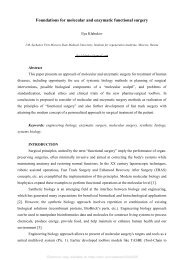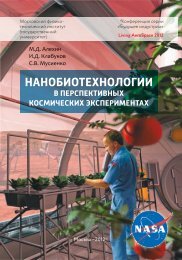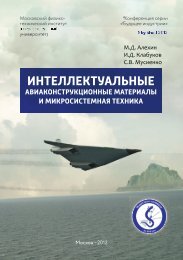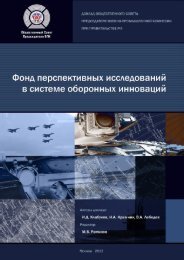Engineering Biology Problems Book (2021, Obninsk Edition)
You also want an ePaper? Increase the reach of your titles
YUMPU automatically turns print PDFs into web optimized ePapers that Google loves.
[48,49,50.Rosanas-Urgell, A., Lin, E., Manning, L., Rarau, P., Laman, M., Senn, N., ... & Aponte, J. J.
(2012). Reduced risk of Plasmodium vivax malaria in Papua New Guinean children with Southeast
Asian ovalocytosis in two cohorts and a case-control study. PLoS medicine, 9(9), e1001305.
Crisp, A., Boschetti, C., Perry, M., Tunnacliffe, A., & Micklem, G. (2015). The expression of multiple
horizontally acquired genes is a hallmark of both vertebrate and invertebrate genomes. Genome
Biology, 16(1), 50.
Genetically modified people. The Economist. 14 March 2015. Retrieved 17 March 2015.]
2.36 The Equation of Life. Humanist ideas, scientific, technical, and medical progress lead
humankind out of stabilizing natural selection. This leads to the accumulation of detrimental
mutations that can potentially cause the extinction of the species. Create a mathematical model to
show if the accumulation of detrimental mutations can lead to humankind’s extinction.
SOLUTION: the task is dedicated to fundamental processes lying based on species formation. While a
species is the main unit of evolution, the main material of evolution is genetic mutations. Several
models are describing the dynamics of the world population [51]. At the same time, mathematical
models that would take into account harmful mutations accumulation are not extant yet.
[51 Korotaev A.V., Malkov A.S., Khalturina D.A. "Mathematical model of population growth,
economics, technology and education" - M., Institute of Applied Mathematics. M.V. Keldysh RAS,
2005 - http://www.keldysh.ru/papers/2005/prep13/prep2005_13.html.]
2.37 Precision Oncology. Comparisons of the patterns of mRNA levels across different human cell
types show that the level of expression of almost every active gene is different. The patterns of mRNA
abundance are so characteristic of a cell type that they can be used to determine the tissue of origin of
cancer cells, even though the cells may have metastasized to different parts of the body. By definition,
however, cancer cells are different from their noncancerous precursor cells. How do you suppose then
that patterns of mRNA expression might be used to determine the tissue source of human cancer?
© John Wilson, Tim Hunt. Molecular Biology of the Cell 6E - The Problems Book, 2015. (7-12)
SOLUTION:
Although cancer cells indeed differ the resolution of the lens should correspond to their normal
precursors, they typically differ in their expression of only a relatively few genes (oncogenes and
tumor suppressor genes). When the overall patterns of mRNAs in cancer cells are compared with the
patterns of mRNAs in normal tissues, they match for the great majority of mRNAs. This RNA
signature allows a tumor to be definitively assigned to a particular tissue type. The field of medicine
based on this principle is called precision (personalized) oncology [52].
[52.Mileyko, V., Ivanov, M., Novikova, E., Telysheva, E., Chernenko , P., Breder, V., ... & Baranova,
A. (2016). NGS for precision medicine in non-small cell lung cancer: Challenges and opportunities.
Annals of Oncology, 27 (suppl_6), 119P. doi: 10.1093 / annonc / mdw363.6]
2.38 False progress. Progress in cancer therapy is often measured in terms of the fraction of patients
that are alive 5 years after their initial diagnosis. For example, in the United States in 1970, 7% of
lung cancer patients were alive after 5 years, whereas in 2000, 14% survived for 5 years. Although
this modest improvement might suggest a corresponding improvement in lung cancer therapy, many
oncologists don’t think therapy for this form of cancer has improved at all. In the absence of a
significant change in treatment, how can it be that a higher percentage of lung cancer patients now
live 5 years after their initial diagnosis?
© John Wilson, Tim Hunt. Molecular Biology of the Cell 6E - The Problems Book, 2015. (pr. 20-68).
SOLUTION:
disease is caused by an autosomal mutation leading to a deficiency of the enzyme
N-acetylglucosamine phosphotransferase, as a result of which the formation of mannose-6-phosphate
does not occur. The GNPTA gene is localized to region q21-q23 on chromosome 4.












